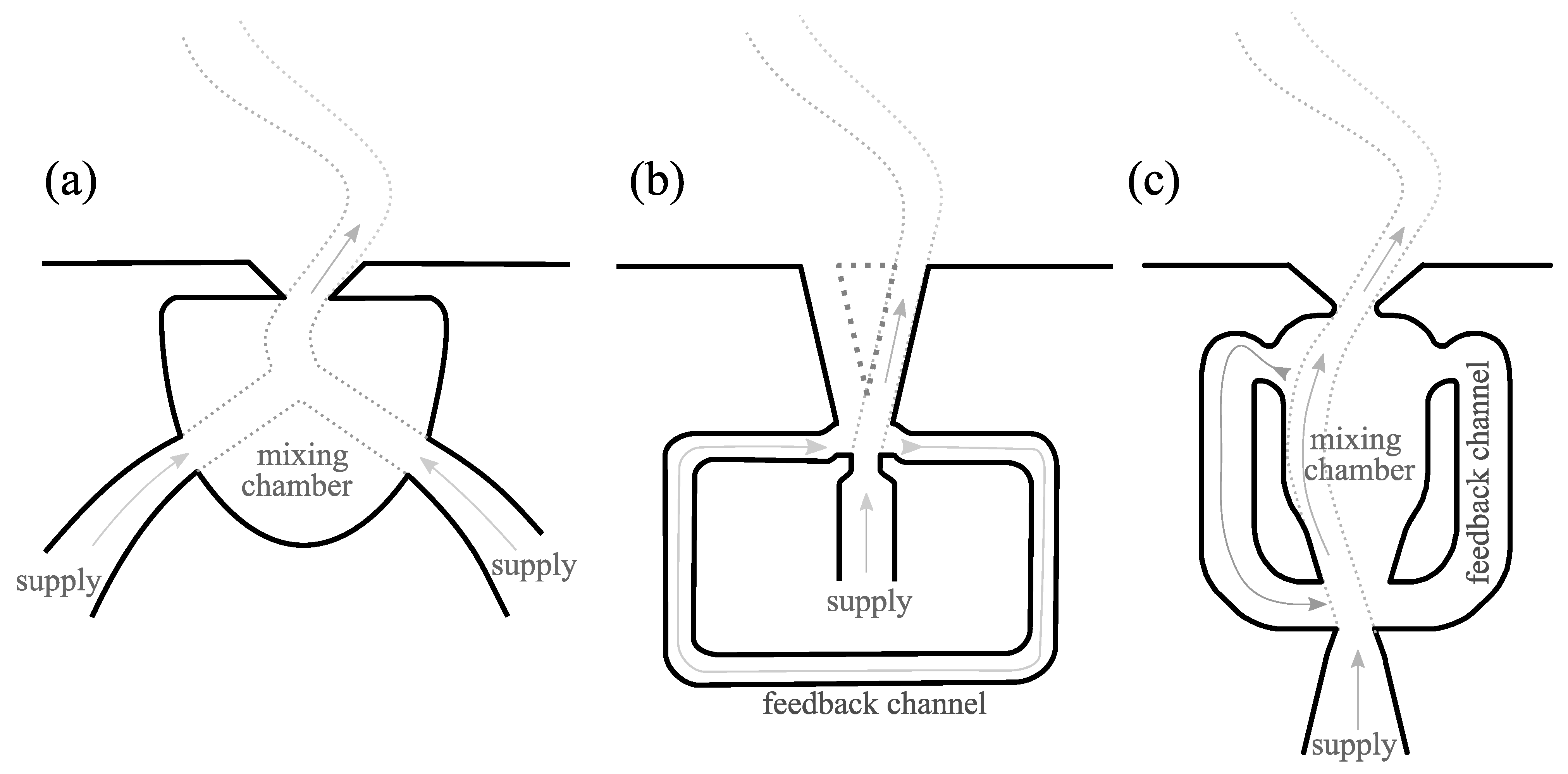Editorial for the Special Issue on “Fluidic Oscillators—Devices and Applications”
Conflicts of Interest
References
- Woszidlo, R.; Ostermann, O.; Schmidt, H.-J. Fundamental Properties of Fluidic Oscillators for Flow Control Applications. AIAA J. 2019, 57, 978–992. [Google Scholar] [CrossRef]
- Viets, H. Flip-Flop Jet Nozzle. AIAA J. 1975, 13, 1375–1379. [Google Scholar] [CrossRef]
- Srinivas, T.; Vasudevan, B.; Prabhu, A. Performance of Fluidically Controlled Oscillating Jet. In Turbulence Management and Relaminarisation; International Union of Theoretical and Applied, Mechanics; Liepmann, H.W., Narasimha, R., Eds.; Springer Science and Business Media LLC.: Berlin/Heidelberg, Germany, 1988; pp. 485–494. [Google Scholar]
- Gregory, J.W.; Sullivan, J.P.; Raman, G.; Raghu, S. Characterization of the Microfluidic Oscillator. AIAA J. 2007, 45, 568–576. [Google Scholar] [CrossRef]
- Raghu, S. Feedback-Free Fluidic Oscillator and Method. U.S. Patent No. 6,253,782B, 3 July 2001. [Google Scholar]
- Spyropoulos, C.E. A Sonic Oscillator. In Proceedings of the Fluid Amplification Symposium, Harry Diamond Lab, Washington, DC, USA, 26–28 October 1965; Volume III, pp. 27–52. [Google Scholar]
- Stouffer, R.; Bower, R. Fluidic Flow Meter with Fiber Optic Sensor. U.S. Patent No. 5,827,976A, 27 October 1998. [Google Scholar]
- Fluidic Amplifier Associates. Fluidics Quarterly; Delbridge Publishing Company: St. Louis, MI, USA, 1965; Volume 1–14. [Google Scholar]
- Gregory, J.; Tomac, M.N. A Review of Fluidic Oscillator Development and Application for Flow Control. In Proceedings of the 43rd Fluid Dynamics Conference, San Diego, CA, USA, 24–27 June 2013. [Google Scholar]
- Campagnuolo, C.J.; Lee, H.C. Review of Some Fluid Oscillators; Tech. Rept. HDL-TR-1438; Harry Diamond Laboratory: Washington, DC, USA, 1969. [Google Scholar]
- Cerretelli, C.; Kirtley, K. Boundary Layer Separation Control with Fluidic Oscillators. J. Turbomach. 2009, 131, 041001. [Google Scholar] [CrossRef]
- Seele, R.; Tewes, P.; Woszidlo, R.; McVeigh, M.A.; Lucas, N.J.; Wygnanski, I.J. Discrete Sweeping Jets as Tools for Improving the Performance of the V-22. J. Aircr. 2009, 46, 2098–2106. [Google Scholar] [CrossRef]
- Andino, M.Y.; Lin, J.C.; Roman, S.; Graff, E.C.; Gharib, M.; Whalen, E.A.; Wygnanski, I.J. Active Flow Control on Vertical Tail Models. AIAA J. 2019, 57, 3322–3338. [Google Scholar] [CrossRef] [PubMed]
- Raman, G.; Raghu, S. Miniature Fluidic Oscillators for Flow and Noise Control—Transitioning from Macro to Micro Fluidics. In Proceedings of the Fluids 2000 Conference and Exhibit, Denver, CO, USA, 19–22 June 2000. [Google Scholar]
- Raman, G.; Raghu, S. Cavity Resonance Suppression Using Miniature Fluidic Oscillators. AIAA J. 2004, 42, 2608–2612. [Google Scholar] [CrossRef]
- Guyot, D.; Paschereit, C.O.; Raghu, S. Active Combustion Control Using a Fluidic Oscillator for Asymmetric Fuel Flow Modulation. Int. J. Flow Control 2009, 1, 155–166. [Google Scholar] [CrossRef]
- Hossain, M.A.; Ameri, A.; Gregory, J.W.; Bons, J.P. Experimental Investigation of Innovative Cooling Schemes on an Additively Manufactured Engine Scale Turbine Nozzle Guide Vane. J. Turbomach. 2021, 143, 1–39. [Google Scholar] [CrossRef]
- Löffler, S.; Ebert, C.; Weiss, J. Fluidic-Oscillator-Based Pulsed Jet Actuators for Flow Separation Control. Fluids 2021, 6, 166. [Google Scholar] [CrossRef]
- Koklu, M. Performance Assessment of Fluidic Oscillators Tested on the NASA Hump Model. Fluids 2021, 6, 74. [Google Scholar] [CrossRef]
- Liebsch, J.; Paschereit, C.O. Oscillating Wall Jets for Active Flow Control in a Laboratory Fume Hood—Experimental Investigations. Fluids 2021, 6, 279. [Google Scholar] [CrossRef]
- Ćosić, B.; Waßmer, D.; Genin, F. Integration of Fluidic Nozzles in the New Low Emission Dual Fuel Combustion System for MGT Gas Turbines. Fluids 2021, 6, 129. [Google Scholar] [CrossRef]
- Fink, A.; Nett, O.; Schmidt, S.; Krüger, O.; Ebert, T.; Trottner, A.; Jander, B. Free Stream Behavior of Hydrogen Released from a Fluidic Oscillating Nozzle. Fluids 2021, 6, 245. [Google Scholar] [CrossRef]
- Adhikari, A.; Schweitzer, T.; Lückoff, F.; Oberleithner, K. Design of a Fluidic Actuator with Independent Frequency and Amplitude Modulation for Control of Swirl Flame Dynamics. Fluids 2021, 6, 128. [Google Scholar] [CrossRef]
- Schweitzer, T.; Hörmann, M.; Bühling, B.; Bobusch, B. Switching Action of a Bistable Fluidic Amplifier for Ultrasonic Testing. Fluids 2021, 6, 171. [Google Scholar] [CrossRef]
- Tesař, V. Fluidic Oscillators Mediating Generation of Microbubbles (Survey). Fluids 2021, 6, 77. [Google Scholar] [CrossRef]
Publisher’s Note: MDPI stays neutral with regard to jurisdictional claims in published maps and institutional affiliations. |
© 2022 by the authors. Licensee MDPI, Basel, Switzerland. This article is an open access article distributed under the terms and conditions of the Creative Commons Attribution (CC BY) license (https://creativecommons.org/licenses/by/4.0/).
Share and Cite
Woszidlo, R.; Krüger, O. Editorial for the Special Issue on “Fluidic Oscillators—Devices and Applications”. Fluids 2022, 7, 91. https://doi.org/10.3390/fluids7030091
Woszidlo R, Krüger O. Editorial for the Special Issue on “Fluidic Oscillators—Devices and Applications”. Fluids. 2022; 7(3):91. https://doi.org/10.3390/fluids7030091
Chicago/Turabian StyleWoszidlo, Rene, and Oliver Krüger. 2022. "Editorial for the Special Issue on “Fluidic Oscillators—Devices and Applications”" Fluids 7, no. 3: 91. https://doi.org/10.3390/fluids7030091
APA StyleWoszidlo, R., & Krüger, O. (2022). Editorial for the Special Issue on “Fluidic Oscillators—Devices and Applications”. Fluids, 7(3), 91. https://doi.org/10.3390/fluids7030091





